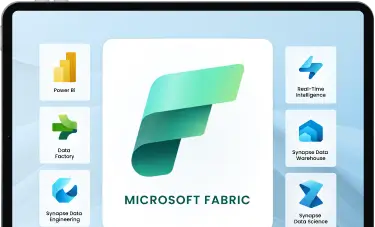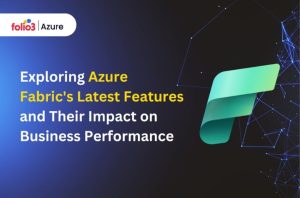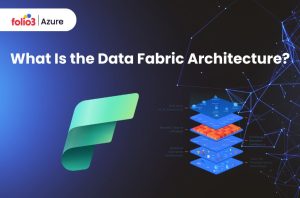Table of Contents
ToggleThe world that we live in today is overwhelmed by the massive influx of data, and managing vast amounts of data to reap its maximum benefits is crucial for any organization. Implementing Microsoft Fabric can provide an excellent solution for your business’s data requirements. Whether you want to refine your data fabric architecture or merge your data management practices, Microsoft Fabric provides an exceptional cloud data platform.
This blog will explore everything you need to know about Microsoft Fabric implementation for organizations in depth.
Accelerate smart decisions with Microsoft Fabric's unified data and AI analytics.

Key Components and Features of Microsoft Fabric
Microsoft Fabric is designed to simplify and enhance your data processes. Let’s go through some of Microsoft Fabric’s components and features:
1. Unified Data Management
Microsoft Fabric provides a single integrated platform for managing all your business data processes. Data processing is made simpler and more efficient owing to this unification. Organizations can eliminate redundant data and guarantee uniform data quality by merging different data sources.
Data silos are removed by an all-encompassing technique, which improves data governance and reporting accuracy between departments.
2. Data Fabric Architecture
The Data Fabric architecture of Microsoft Fabric facilitates smooth data integration across various sources, providing a collective picture of your data. This architectural design ensures that data can transition smoothly and flawlessly between different systems, enabling detailed analytics and insights.
The architecture’s adaptability allows you to integrate multiple data formats that accommodate structured and unstructured data sources.
3. Cloud Data Platform
Microsoft Fabric is a cloud-based solution that facilitates scalability, reliability, and accessibility. It allows you to utilize cloud technology for your data requirements. The cloud platform supports dynamic scaling, which means your data infrastructure can grow with your organization’s data needs, thus freeing you from the limitations of on-premises solutions.
Moreover, the cloud environment offers strict and adequate security measures, including data encryption and multi-factor authentication, ensuring your data remains secure and complies with industry standards.
4. Microsoft Fabric Integration
Microsoft Fabric has a considerable edge when integrating with other Microsoft products and third-party tools, as it smoothly integrates with them. Thus, it ensures that you can continue using your preferred software without disruptions.
Its powerful Integration capabilities encompass popular tools like Power BI, Azure Data Factory, and more, making creating a connected data environment more accessible. This integration boosts productivity by organizing workflows and requires minimum time for employees to acquaint them with the new system.
By employing these features, organizations can simplify their data processes and improve data accessibility and overall operational efficiency.
Steps to Implement Microsoft Fabric in Your Organization
Here are the steps for a successful and smooth implementation of Microsoft Fabric in your organization.
The first step in implementing Microsoft Fabric is setting up the environment. Here’s a simplified overview:
Installation and Configuration Steps
- Purchase and License: Acquire the licenses required for Microsoft Fabric through your Microsoft account. This step involves selecting a suitable plan based on your organization’s size and requirements. It’s important to assess different licensing options to choose a plan that matches your long-term data strategy and budget.
- Download and Install: Download the Microsoft Fabric setup files from its official site and follow the installation instructions. To avoid installation issues, ensure your system meets the necessary hardware and software requirements. An initial system check can help identify any potential gaps in the current infrastructure that must be handled before installation.
- Configure Settings: You must customize the initial settings according to your organizational needs, including data storage locations, user permissions, and security protocols. This customization ensures that the platform is personalized according to your operational requirements. Setting up clear data governance policies at this stage can help maintain data integrity and security.
Initial Setup and Customization
After the successful installation, you’ll need to tailor Microsoft Fabric to match your requirements:
User Accounts
Set up user accounts and access levels to guarantee flawless data security and compliance. Implement role-based access control (RBAC) to manage permissions. This technique helps in protecting sensitive data and ensures that users have access only to the information they need for their roles.
Data Sources
Now connect Microsoft Fabric to your current data sources, whether on-premises databases or at other cloud platforms. This connectivity is mandatory to ensure that all required data is available within the Fabric environment. Regularly updating these connections ensures that your data remains updated and facilitates real-time decision-making.
Integration with Tools
To facilitate the easy flow of data and continuity of operations, ensure smooth integration with other enterprise tools and software. Utilize APIs and connectors to link Fabric with your existing IT environment. Continuous monitoring and maintenance can prevent data flow disruptions and boost system performance.
Data Migration and Integration
Strategies for Migrating Existing Data
Data migration is a fundamental part of Microsoft Fabric implementation. Here are some tips to ensure a smooth transition:
Assessment and Planning
Take a keen look at your existing data environment. Determine which data needs to be moved, then schedule the transfer in phases. This stepwise strategy helps reduce risks and manage the transfer more effectively.
Using automated technologies for data mapping and transformation may make this procedure more efficient and less prone to human error.
Data Cleansing
Clean and standardize your data before migrating to prevent inaccurate data transmission. Data cleansing includes eliminating duplication, rectifying errors, and guaranteeing data consistency. High standards of data integrity must be ensured, and this process can be automated by implementing data quality tools.
Testing and Validation
Test the migration process on a small data set to identify possible issues. Validate the migrated data to ensure accuracy. This step helps detect and rectify any migration-related problems before they affect the entire data set. After migration, continuous data validation ensures constant accuracy and reliability.
Ensuring Seamless Integration with Other Tools
Follow these steps to ensure a smooth integration, which is the key to maximizing the benefits of Microsoft Fabric:
Use Connectors
Take advantage of Microsoft Fabric’s built-in connectors to integrate with popular tools like Power BI, Azure Data Factory, and third-party applications. These connectors simplify the integration process and improve data compatibility. Frequently updating these connectors ensures compatibility with new versions of integrated tools.
API Integrations
Use API integrations to facilitate smooth data transmission between systems for custom tools. APIs provide a flexible and scalable way to connect different applications and systems. Establishing effective API management practices can help maintain the performance and security of these integrations.
Continuous Monitoring
Monitor the integration process to ensure constant compatibility and performance. Review and adjust integration settings regularly to maintain efficiency. Implementing automated monitoring tools can notify you of any integration issues in real-time, allowing for quick rectification.
Training and Support
Training Programs for Employees
Successful implementation of Microsoft Fabric requires thorough training for your team:
Initial Training
Provide initial training sessions for your IT staff and users to familiarize them with the platform. These sessions should cover the basics of using Microsoft Fabric. Interactive training methods, such as hands-on experience can enhance learning.
Role-Based Training
Provide role-based training that is personalized to the exact needs of different user groups in your organization. For example, data analysts might need in-depth training in data querying and visualization, while IT administrators need training in system configuration and security.
Ongoing Learning
Encourage and motivate your team to learn continuously through workshops, webinars, and online resources provided by Microsoft. Keep your team updated about the latest features to gain long-term success. Promoting a continuous improvement and learning culture can enhance the adoption and usage of Microsoft Fabric.
Ongoing Support and Resources
Ensure that your team has access to ongoing support and resources:
Technical Support
Use Microsoft’s technical support services for help and troubleshooting. Access to professional assistance may minimize operational problems and downtime. Plans for proactive assistance can also help predict problems and find solutions before they impact operations.
Community Forums
Participate in community forums and user groups to stay updated about best practices and the latest features. Connecting with the user community can provide valuable information and solutions to common problems. Contributing to these communities can also build your organization’s reputation as a knowledgeable and collaborative entity.
Documentation and Tutorials
Regularly refer to Microsoft’s comprehensive documentation and tutorials for guidance. These resources offer step-by-step instructions and detailed information on all features of Microsoft Fabric. Keeping your knowledge updated can help in quick referencing and problem-solving.
Conclusion
Introducing Microsoft Fabric into your organization could drastically boost your data management skills. You can fully utilize the potential of this strong platform by understanding its vital components, following the setup and integration procedures, and making sure you receive the necessary training and assistance.
Microsoft Fabric is a great option for businesses trying to streamline their data operations because of its unified data management and strong cloud data platform.
To root out further into advanced data solutions and analytics, consider exploring our Azure Data Analytics services, where we offer expert and personalized solutions to help you utilize your data bank to its full potential.
By implementing Microsoft Fabric, your organization can stay competitive and ahead in the data-driven business environment, ensuring efficient, scalable, and secure data management. Start your journey today and revamp your data infrastructure with Microsoft Fabric.


